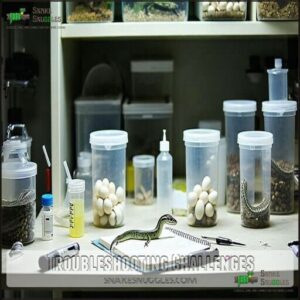This site is supported by our readers. We may earn a commission, at no cost to you, if you purchase through links.
 To breed a snake successfully, start by choosing healthy, mature snakes of compatible species.
To breed a snake successfully, start by choosing healthy, mature snakes of compatible species.
Provide separate enclosures with the proper temperature gradient, humidity, and hiding spots.
Introduce the male and female during breeding season, ensuring conditions mimic their natural habitat. Look for signs of mating like coiled tails.
Once gravid (pregnant), the female will need a comfortable, well-heated enclosure and plenty of food to support egg development.
Lay eggs in a moist, warm incubation box if your snake isn’t live-bearing.
The process requires patience, precision, and care—but seeing healthy hatchlings makes it worth the effort.
Curious about raising babies? Keep reading!
Table Of Contents
- Key Takeaways
- Preparing Your Snakes to Breed
- Introducing Snakes and Mating
- Signs Your Snakes Have Mated Successfully
- Caring for The Pregnant Snake
- Identifying When The Snake Will Give Birth
- Helping With The Birthing Process
- Caring for Baby Snakes
- Feeding Baby Snakes Properly
- Monitoring Health and Growth
- Troubleshooting Challenges
- Frequently Asked Questions (FAQs)
- How do I get my snakes to breed?
- How much money do snake breeders make?
- Is snake breeding legal?
- How hard is snake breeding?
- How can I confirm the sex of my snakes before attempting to breed them?
- How long do snake eggs take to hatch?
- Can inbreeding cause genetic health problems?
- What are common snake breeding complications?
- How profitable is snake breeding business?
- Do all snake species breed the same way?
- Conclusion
Key Takeaways
- Choose healthy snakes with proper genetic screening, vet checks, and quarantine protocols to ensure compatibility and the best breeding success.
- Set up enclosures with temperature gradients, high humidity, hiding spots, and nesting areas that mimic natural habitats.
- Introduce snakes during breeding season, monitor courtship behaviors like coiling tails, and separate if aggression occurs.
- Care for gravid females with stress-free environments, proper nutrition, and specific housing needs to support egg development or live birth.
Preparing Your Snakes to Breed
If you’re serious about breeding snakes, you’ll need to select your reptilian partners with scientific precision and careful attention to their genetics, health, and compatibility.
Before introducing potential mates, verify each snake’s age, weight, and temperament to guarantee the best chance of successful reproduction and healthy offspring.
Choosing Healthy Snakes
Wondering how to kick-start your snake breeding journey?
Selecting the right reptilian partners is vital for success. Here’s your roadmap to choosing healthy snakes:
- Conduct thorough genetic screening to confirm strong bloodlines
- Perform a complete temperament assessment
- Verify ideal weight and physical condition
- Schedule a professional veterinary checkup
- Implement strict quarantine protocols
Your snake breeding guide begins with careful selection—where health, genetics, and compatibility converge to create the perfect breeding pair.
Housing Requirements
Every successful snake breeding journey starts with a rock-solid snake enclosure.
Choose a spacious terrarium that gives your serpents room to roam—at least two-thirds the length of their body.
Your snake enclosures should feature a secure, ventilated top and maintain essential temperature gradients from 80-85°F with a 90-92°F basking zone.
Mix substrate types like coconut husk or cypress chips for comfort and moisture control.
A significant aspect involves appropriate enclosure size to facilitate natural behaviors.
Strategically place multiple hiding spots to reduce stress and mimic natural environments.
Include a water dish large enough for soaking, and position the enclosure in a quiet area away from temperature fluctuations.
Remember: a well-designed habitat isn’t just housing—it’s your snakes’ breeding sanctuary.
Setting Up Ambient Conditions
With your snake housing ready, fine-tuning the ambient conditions becomes vital for successful breeding. Creating the perfect environment requires precision and care.
- Establish temperature gradients ranging from 75-85°F, with a basking spot at 90°F
- Use heat mats or ceramic emitters to create natural thermal zones
- Maintain humidity around 60% through strategic substrate and water placement
- Assure consistent airflow and fresh water availability
- Monitor environmental conditions to minimize stress and optimize breeding potential
Temperature and photoperiod greatly influence snake reproductive behaviors.
Consider using a reptile under tank heater for appropriate thermal regulation.
By mimicking natural habitat conditions, you’ll create an ideal breeding environment that supports your snakes’ physiological needs, transforming your enclosure from a simple habitat to a sophisticated reptile breeding setup.
Introducing Snakes and Mating
Starting the mating process is where the magic happens.
Begin by placing the female into the male’s enclosure to encourage natural snake courtship.
Make sure the setup includes a temperature gradient of 75-85°F on the cool side and 85-92°F on the warm side. This helps mimic their natural environment and supports the mating process.
Watch for these courtship behaviors:
- The male may flick his tongue, bob his head, or crawl over the female.
- The female shows interest by lifting her tail or gaping her cloaca.
- Copulation can last an hour or more—patience is key!
Keep the enclosure calm and stress-free.
If either snake shows signs of aggression, separate them immediately to avoid injuries.
You can also try pheromone use or misting to stimulate interest.
Once the pair bonds, successful copulation observation often leads to eggs or live young, depending on the species.
Signs Your Snakes Have Mated Successfully
After successfully introducing your snakes and observing initial mating behaviors, you’ll want to confirm their reproductive success.
Recognizing pregnancy signs requires a keen eye and patience.
| Sign | Indicator | Probability |
|---|---|---|
| Belly Shape | Stretched/Bulging | High |
| Behavior | Reduced Appetite | Medium |
| Physical Changes | Subtle Vent Enlargement | Moderate |
During copulation observation, note the mating ball formation and prolonged copulation duration.
A gravid female might display unique nesting behavior, pushing substrate around her enclosure.
Watch for shedding changes and subtle weight gain as pregnancy indicators.
The male might seem disinterested in food, while the female becomes more territorial.
These nuanced signs reveal your snakes have likely mated successfully, setting the stage for exciting breeding prospects.
Caring for The Pregnant Snake
When your snake is pregnant, you’ll need to create a specialized environment that supports her unique needs during this critical reproductive phase.
Create a stress-free habitat with perfect temperature, humidity, and privacy to ensure your pregnant snake thrives.
You’ll want to focus on providing a comfortable, stress-free habitat with precise temperature and humidity controls to guarantee the health of both the mother and her developing offspring.
Providing Proper Housing
In the delicate dance of snake breeding, your pregnant serpent needs a sanctuary that whispers comfort and security. Craft an 18"x18"x12" breeding enclosure with precision, keeping her stress at bay.
- Aspen shavings or paper towels create the perfect substrate
- Multiple hiding spots offer privacy and temperature control
- Fresh water bowl assures constant hydration
- Strategic placement in a quiet room completes her breeding haven
Maintaining proper temperature gradients is also paramount for their well-being.
Offering Appropriate Food
Nourish your pregnant snake with precision by upgrading her prey size 15-20% larger than her usual meals.
Opt for thawed frozen rodents, steering clear of live prey to minimize risks. Match her feeding frequency to her body condition, making certain she maintains excellent health.
Your snake’s diet should rely on whole prey, which naturally delivers complete nutrition without supplementation. Consider specialized food options for excellent nutrition.
From pinky to hopper mice, choose prey that supports her changing nutritional demands during pregnancy, keeping her well-fed and thriving.
Identifying When The Snake Will Give Birth
After nurturing your pregnant snake through careful housing and nutrition, you’ll want to recognize her impending birthing signals.
Watch for telltale gestation signs that herald the approaching parturition timing. Her body will transform, displaying a noticeably swollen abdomen and a dramatic shift in shape.
Expect a pre-lay shedding phase about two weeks before birth, where her scales appear dull and she’ll shed her skin in one complete piece.
Nesting behavior becomes pronounced as she seeks warm, secure spots and may stop eating altogether.
These physical and behavioral changes signal your gravid female is preparing for egg laying. Her instincts will guide her, but your keen observation assures you’re ready for the upcoming birthing process.
Understanding these subtle cues helps you support her through this critical reproductive stage.
Helping With The Birthing Process
After tracking your gravid female’s pregnancy, you’re now at the snake birthing moment. Most snake births progress naturally, but knowing when to step in matters.
Watch for these birthing signals:
- Restless coiling and body repositioning
- Slight muscular contractions
- Membrane-covered offspring emerging
- Unusual labored movements
Intervention becomes necessary if:
- Labor extends beyond 6 hours
- Babies remain trapped in membranes
- Mother shows clear distress
- Birth canal appears blocked
During dystocia intervention, maintain a warm, calm environment. Keep a soft, clean surface nearby and minimize handling.
Your role isn’t to micromanage but to provide subtle support.
Professional help might be required for complex scenarios like breech births or c-section risks. Stay observant, patient, and ready to consult a veterinarian specializing in reptile postpartum care.
Caring for Baby Snakes
Now that your snake hatchlings have emerged, it’s time to create their perfect sanctuary. Baby snake care requires precision and patience.
Baby snake care is all about patience, precision, and creating a safe, nurturing space for them to thrive.
Your snake hatchlings need a specialized environment to thrive:
- Choose compact glass aquariums with excellent ventilation
- Provide multiple hiding spots for security
- Maintain consistent temperature and humidity levels
Select small tanks that make hunting comfortable and include a hide box, fresh water, and natural decorative elements like branches or bark.
Aspen shavings or newspaper work well as substrate, creating a comfortable habitat that mimics their natural environment.
Selecting the right enclosure involves researching appropriate tank sizes. Resist immediate handling.
These tiny reptiles need time to adjust to their new world. Watch them closely, monitoring their first movements and early signs of strength.
Each snake hatchling’s initial days are critical for long-term development.
Remember, your careful setup and observant approach will help these baby snakes start their journey on the right path.
Feeding Baby Snakes Properly
After bringing your baby snakes into the world, their nutrition becomes your top priority.
Forget one-size-fits-all approaches—each hatchling demands precision in their feeding strategy. Your secret weapon? A carefully crafted feeding schedule matched to their growth stage.
Pro tip: Always choose pre-killed prey that matches your snake’s head width.
Online sources offer frozen pinky mice perfect for baby snake nutrition.
Watch for warning signs like regurgitation or lethargy—these signal potential feeding mishaps.
Your attentive care transforms these tiny meals into a robust foundation for a healthy, thriving reptile companion.
Monitoring Health and Growth
After carefully feeding your baby snakes, you’ll want to keep a close eye on their development. Think of yourself as a snake detective, tracking their every move and milestone.
Here’s your playbook for monitoring snake health and growth:
- Weigh In Weekly: Use a precise digital scale to track snake weight, ensuring steady gains that signal robust health.
- Length Matters: Measure your snakelet’s length regularly, creating a growth chart that tells their developmental story.
- Skin Deep Insights: Watch shedding patterns closely—clean, complete sheds indicate a thriving reptile.
- Behavior Baseline: Note activity levels, appetite, and interactions, flagging any unusual changes quickly.
Your attentive observations are the secret weapon in catching potential health hiccups early, giving your baby snakes the best shot at a strong, healthy life.
Troubleshooting Challenges
Breeding snakes isn’t always smooth sailing. Problems like infertility, egg binding, or genetic defects can make you feel like you’re in over your head.
But don’t panic—every breeder faces snake breeding challenges.
Keep an eye out for birthing complications, unusual swelling, or appetite loss, as these could signal deeper issues. A herpetologist can help untangle these mysteries and guide you through solutions.
Here’s a quick troubleshooting guide:
| Issue | Possible Cause | What to Do | Prevention |
|---|---|---|---|
| Infertility | Poor pairing or stress | Consult a vet | Pair compatible snakes |
| Egg binding | Low humidity | Increase moisture, seek help | Monitor humidity levels |
| Genetic defects | Hybridization issues | Avoid risky pairings | Research genetic compatibility |
| Post-breeding health | Nutritional deficiencies | Adjust diet, vet check | Provide balanced feeding |
Remember, every setback teaches you something new. Stay patient and adaptable—your snakes will thank you!
Frequently Asked Questions (FAQs)
How do I get my snakes to breed?
Start by pairing a healthy male and female of the same species during breeding season.
Introduce the female into the male’s enclosure, mimic natural conditions with temperature and humidity tweaks, and monitor for courtship behaviors.
How much money do snake breeders make?
Some breeders earn over $10,000 annually, especially with high-demand morphs like piebald ball pythons.
Profits depend on species, genetics, and care costs.
Be ready to invest time, money, and patience for success!
Is snake breeding legal?
Snake breeding legality depends on your location and species.
Some regions require permits, especially for endangered or exotic snakes.
Research local laws, as violations can lead to hefty fines or confiscation of your snakes.
How hard is snake breeding?
It’s challenging but rewarding.
You’ll need patience, knowledge of snake care, and a proper setup.
Maneuvering genetics, feeding, and environmental controls can feel like a juggling act, but the joy of success makes it worthwhile!
How can I confirm the sex of my snakes before attempting to breed them?
Think of your snakes like mysterious puzzles.
To confirm their sex, use tools like probing or popping, but only with proper training.
If unsure, consult a vet or expert to avoid mistakes and injuries. Proper training
How long do snake eggs take to hatch?
Snake eggs typically hatch in 58-62 days, depending on the species, temperature, and humidity levels.
Keep the incubator steady and don’t flip the eggs—baby snakes aren’t fans of surprise gymnastics during development!
Can inbreeding cause genetic health problems?
Yes, inbreeding can cause genetic health issues, like deformities, reduced fertility, and weakened immunity.
It’s like rolling genetic dice—you increase the risk of unfavorable traits popping up, but careful planning minimizes these problems.
What are common snake breeding complications?
Ever wonder what could go wrong when breeding snakes?
Common issues include egg binding, infertility, stress-related illness, or genetic defects.
Monitor their health, provide proper care, and always consult a reptile vet for serious complications!
How profitable is snake breeding business?
Snake breeding can be profitable if you focus on high-demand morphs like ball pythons, selling for $50-$2,
However, initial costs, feeding, and care for hatchlings can eat profits.
Success requires research, planning, and patience.
Do all snake species breed the same way?
Breeding snakes is like nature’s puzzle—with each species requiring specific conditions.
Some need brumation, others don’t.
Variations in temperature, humidity, courtship rituals, and even egg-laying versus live birth make the process unique.
Conclusion
Breeding snakes might seem tricky, but it’s not rocket science if you prepare carefully.
From setting up enclosures to recognizing gravid signs, attention to detail is key.
Mimic their natural habitat, keep temperatures steady, and be patient—it’s worth the wait.
Whether laying eggs in an incubation box or live-bearing, the process can be fascinating.
Follow this how-to breed a snake complete guide with pictures, and soon you’ll watch tiny hatchlings slither into the world!














